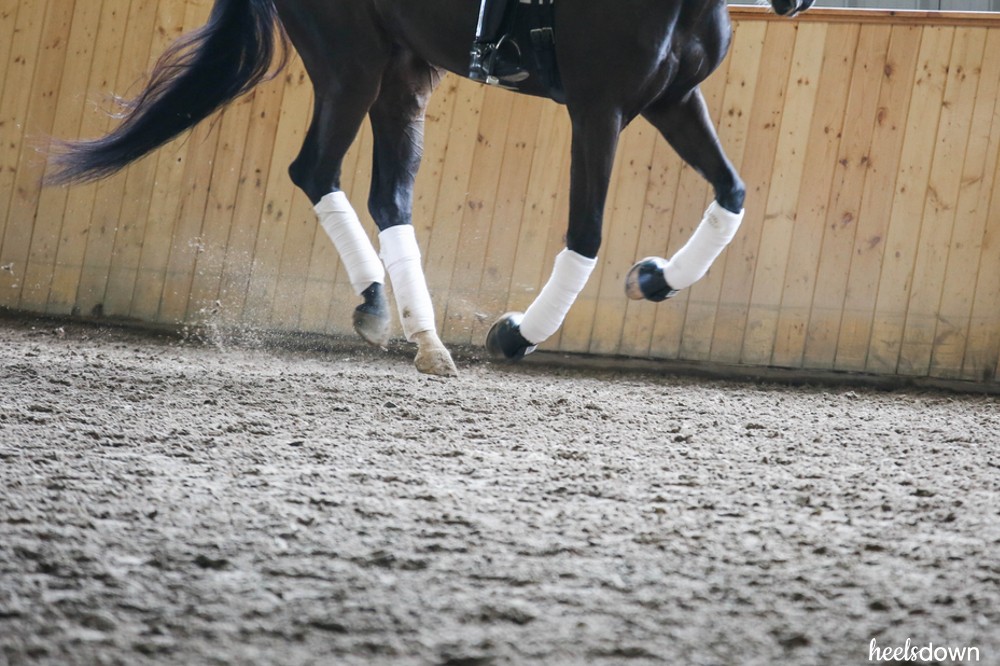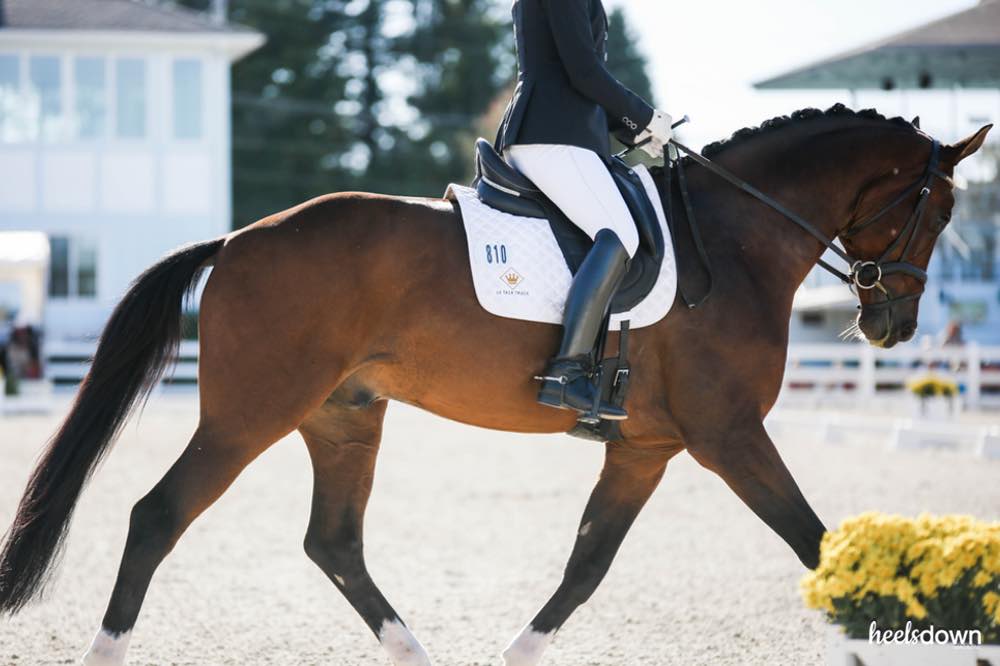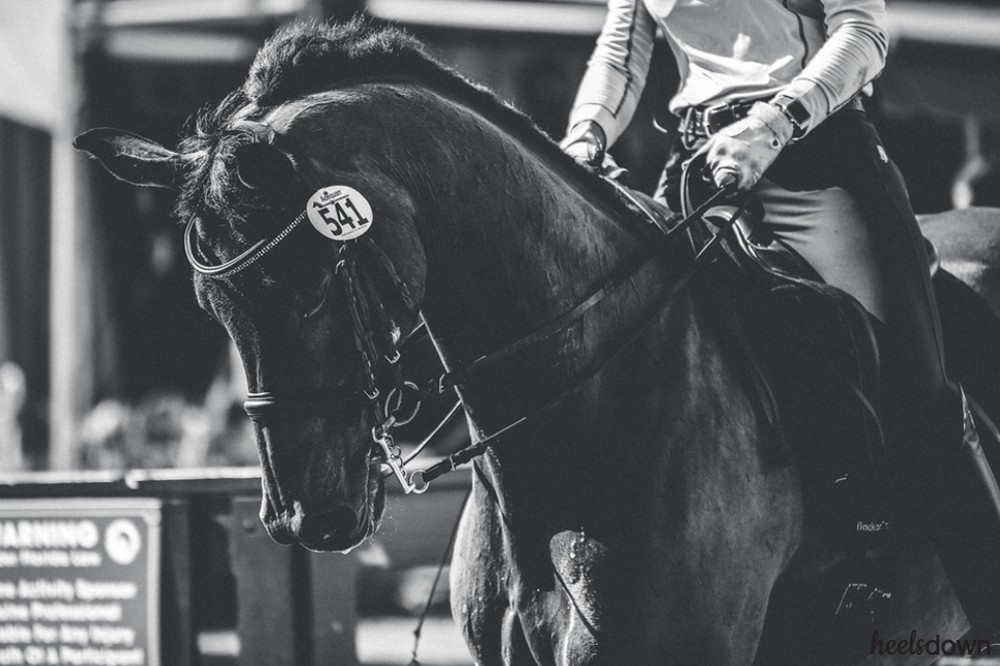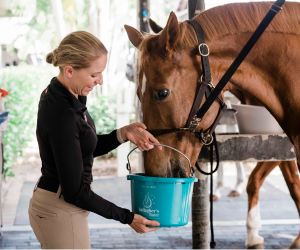Ultimate Strength & Conditioning Guide for Horses: Dressage

Despite the many uncontrollable factors out there that limit riding time — severe weather or injury, to name a few — a horse’s strength and fitness are vital in any riding discipline. Not only for competition, but for overall health.
Heels Down Mag spoke to experts in the three Olympic disciplines – dressage, show jumping and eventing – on how to keep horses happy, sound and physically conditioned. This third installment focuses on dressage.
Developing Muscle Tone
Dressage horses are built to use their own bodies for self carriage and engagement, which require a strong core, back and development through the topline.
For many horses, the neck is often easiest to develop, but it’s more difficult to condition the muscles of the low back, base of the wither and at the base of the neck. These help connect the hind legs to the bridle to achieve true collection. The muscles are made stronger by true collection – but then collection also requires strength.
Don’t Miss The Ultimate Strength And Conditioning Guide For Horses: Eventing
“There’s sort of your chicken and egg thing. When you’re introducing collection as a concept, it’s a lot of putting a horse in a body position that looks like upper levels, letting him fall apart, putting it back together, letting him fall apart, putting back together…until one day he develops the strength to not fall apart. And that takes time,” explains Lauren Sprieser, a grand prix dressage rider and the owner and trainer at Sprieser Sporthorse in Marshall, Va.

Conformation should play a role in any conditioning plan. Some horses are naturally strong in the topline and easily connected, while others “naturally want to be two men in a horse costume,” says Lauren. For the latter types of horses, riding a bit deep in a lower outline helps the horse develop the back muscle needed to carry themselves in more collected position when ready.
“The reality of dressage is that it’s a lot of repetitive boring stuff. It’s kind of like going to the gym or a baseball player going to the batting cage or an Olympic swimmer doing laps. It’s about form, it’s about shape and it’s about low intensity,” Lauren explained. “I do a huge amount of my work on all of my horses in a gait for a 6.5 or 7 (score out of 10 at an FEI standard). I will push for 8-9-10 as they get closer to horse showing, and every now and then, just have to tap the accelerator and make sure it still works. If you crank the power up on a horse to 11 before the body is really strong enough to support it, that’s how they do ligaments and tendon injuries.”
Coming Back After Time Off
Unlike jumping disciplines, where the concussive stress on the limbs may require more downtown and attention, dressage horses tend to struggle with significant time off from exercise, Lauren describes.
It’s kind of like going to the gym or a baseball player going to the batting cage or an Olympic swimmer doing laps. It’s about form, it’s about shape and it’s about low intensity.
“Nothing requires the same amount of top-level strength as dressage,” says Lauren, 33. “Throwing an upper-level dressage horse out in a field and not touching them for a few weeks would be the kiss of death.”
Horses tend to lose those topline muscles quickly without consistent exercise. But it takes a long time to redevelop that muscling once it’s gone.
The general rule of thumb when a horse is coming back from an injury or significant downtime is however long they were off, it takes at least half that long to get back to the fitness level they were at before. But every horse is different, Lauren warns. Some horses do better with more riding days per week and for shorter stints, while others need more days off or a few lighter days.
Read This Next: Show Jumping – The Ultimate Strength And Conditioning Guide For Horses
It’s important to be cognizant of potentially overworking a horse that’s returning to work. If he starts to get sour in the work, that’s a warning sign.
“But it can also be a symptom of being an angry hostile five-year-old that needs to finds Jesus,” jokes Lauren, who generally walks a horse for ten minutes, trains for about 30, and hacks out for about 10 afterward. The goal is to never get the horse worked to the point fatigue.
“I’m always happier to quit five minutes earlier than planned versus five minutes later,” she said.

How to Tell When A Horse is “Fit”
Pay attention to the horse’s breathing. Lauren likes to use the one-star eventing fitness guide: “Can my horse trot for 15 minutes without needing a walk break or sounding like he’s just run the Belmont?” she asks.
If not, she will do trot sets to help with fitness. She also uses an infrared light therapy solarium either before or after work, depending on the horse’s needs, to help increase blood flow to the muscles.
Additional therapies and care can help tremendously when conditioning horses. Turnout, for example, is always important, but especially so when keeping a fit horse healthy and conditioned.
“If you work them for 45 minutes and then stick them in a stall for the rest of the day, they’re going to seize up,” says Lauren.
She also uses a EuroXciser, a brand of “horse walker” at her farm to help get the horses walking more in the afternoons.
“Circulation is everything. When circulation stops, you get inflammation because the horse’s body fluids, the white blood cells and lymphatic system gets stuck, and that’s what causes wind puffs and other things,” she said.

Lauren’s Guide to Dressage Fitness:
Lauren provided the following with FEI-level horses in mind, but this schedule can be customized to fit any level of riding.
Weeks One-Two: In a snaffle bridle, do lots of transitions at the walk, trot and canter in a lower outline. Do them on a 20-meter circle every six strides or so. Sunday and Thursday, hack or add cavaletti. Have more serious rides on Tuesday, Wednesday, Friday and Saturday. Monday is a day off.
Week Three: Start reintroducing the lateral work and picking the horse up to more of a finished product outline, with the poll at highest point. From here on out, give Monday off and Sunday for hacking and/or cavaletti work, and let your horse tell you what he’s up for on the other days. “If he comes out of his stall feeling like a wet pool noodle, it’s not a good day to work on the piaffe/passage transitions,” Lauren explained.
Week Four: Keep the same general schedule as before, increasing work as tolerated. Begin adding the “idea” of piaffe, passage and canter pirouette into your transitions to prepare your horse.
Week Five-Six: Start bringing back piaffe, passage and canter pirouette, if these are movements your horse typically does Start adding to your transitions trot/passage, trot/piaffe, and canter/pirouette canter. Use the whole scale of the horse’s gaits.



